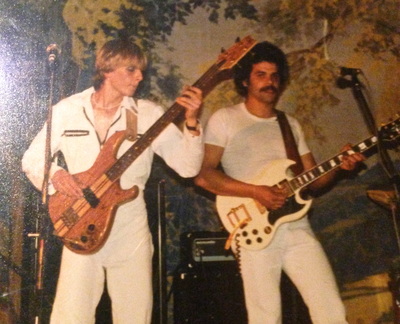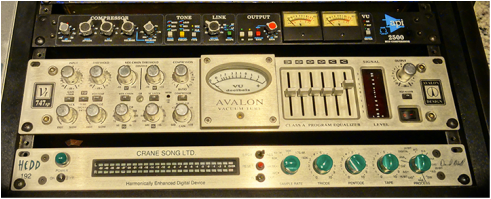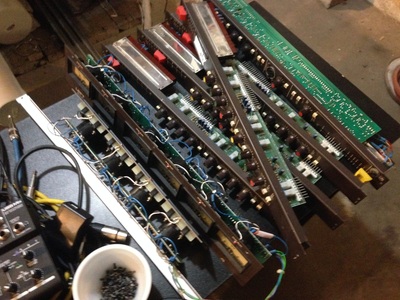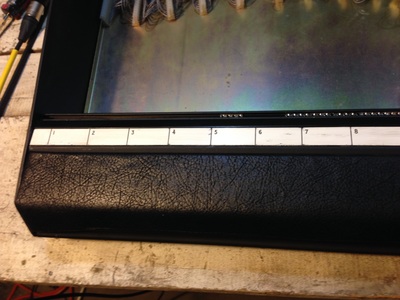|
I just returned from a trip to my home town Hannover, "rock capital of Germany", and I reconnected with some former band mates from almost 40 years ago with whom I had my first recording experiences back in the '70s. Not only was our reunion a superb celebration of friendship- it was a celebration of a dream that we share to this day- to be a musician! What a dream, and how touching it was for me to be reminded where it all started... Little did I know that playing with the group 'Sunset' in 1979 prepared me for a much, much bigger step just a few years later- to move to America, be a full time musician, and play (for my first gig in the US) on Sunset Blvd at the famed Whisky a Go Go. My tiny little dream had expanded into a really big one and had cast me onto a breathtaking trajectory that continues to amaze me to this day. So I guess my point is that tiny dreams can turn into big ones just like that. As I continue to dream up my next chapter I hope that you will take time to dream up yours- and if it involves music, perhaps we can even share in it... 'Sunset' reunion 2016: Hans Christian (bass), Sibylle Burkhardt (lead vocs), Thomas Werner (keys), Leo James Steiner (guitar). Missing is Thilo Woelbling (drums).
1 Comment
Hello, Hans Christian here!
Today I want to share with you one of my passions- the love of high quality microphones. Ever since I laid my hands on my first microphone as a teenager I was fascinated by the idea of using mics on instruments and trying to capture sound as best as possible. Since that first mic (a Sennheiser MD 421 for you geeks out there...) I have bought and sold dozens microphones. I have experimented with all kinds of mics on my cello and have been recorded by other engineers with all kinds of mics, from Coles ribbon mics to AKG 451s, Shure SM57s, and everything inbetween... So what's the new stuff that I just got? Well, for starters, I realized that my beloved NEUMANN M147 tube microphone was pretty badly misbehaving and needed a complete restoration. A new vacuum tube and a new transformer for the power supply needed to be installed, and a thorough professional cleaning of the diaphragm was also in order. This difficult work was expertly done by Tom Onofrio, and the mic is now better than new. While I was waiting for the M147 to be fixed I had a sweet moment of weakness and allowed myself to purchase a long held dream- a PELUSO VTB vacuum tube mic, made by a small American company that has a knack for developing microphones in a vintage style. I wanted to find out how good these mics really are, and after comparing it with the freshly restored Neumann M 147 I couldn't let it go. The M 147 and the VTB compliment each other nicely- they are different enough that I needed to keep them both! So, now I have two top quality large diaphragm tube microphones. But wait, there is more!!! A "casual stroll" on eBay led me to another golden opportunity: a matched pair of TELEFUNKEN M260s, slightly used but in pristine condition. The M260s are also vacuum tube microphones but with a small capsule (or several capsules, as they are interchangeable). These mics were offered by a seasoned engineer, Mr. Stuart Breed, who has had the amazingly good fortune of working with Geoff Emerick on Beatles reissues, amongst many other things. So guess what I'll be doing in the next few days and weeks? Recording of course! If you want to record with these and other high quality gear, drop me a line! I'm always glad to hear from you. Your sound geek... Hans It's a small world...
A couple of days ago I received an email from a Hollywood film composer asking me to play sarangi (the Indian bowed instrument) on a movie soundtrack that he is working on. He said that I was "highly recommended" for the job which needed to be done immediately. Hmm, really? I wondered how that came about. Anyway, I said, "sure I can do that", and he sent 5 music beds the next day, along with some basic instructions. I went to work, and a few hours later I had recorded 15 variations for him, mixed them, and uploaded them. And then I thought that it might be a good idea to actually talk in person. So, I called him and said "hi, this is Hans, I just sent you the sarangi tracks...". We ended up talking music, composition, and future projects and discovered similar musical interests and styles of composition. It was a pure delight! It turned out that a friend of his was at my last concert in Los Angeles last year and loved what he heard that night. Oh, the composer's name? George Kallis. Thank you George! I'm looking forward to doing more music together. In my previous blog (making a living in music, part 1) I focused on the history of the record business over the past 40 years and where we are right now in terms of distribution, listening habits, and royalty streams for musicians.
Another aspect to look at is what kind of business models musicians have these days. It seems to me that "making music" alone is not enough to being a musician. A degree in promotion, social media, accounting, electronic engineering, IT, and an apprenticeship with a moving company might also come in handy. In other words, to be a musician means to be a multitasker. Now, there ARE musicians that have made it to a point in their career where they draw large audiences and make the big bucks or where their recordings generate a nice income through royalties and licensing. We all aspire to that goal, right? So, as a young musician it is important to lay the foundation by getting registered with one of the Performing Rights Organizations as a writer and as a publisher. I did this in my early 20s when I was asked to co-write a few songs with composer John Cacavas for a TV mini series called "Jenny's War". This series was aired all over the world and I received royalties from BMI for years. It showed me the importance of registering everything that I do with BMI as a writer and a publisher. Also, it is really important to get real with yourself by asking "what kind of artist am I?". Do you like performing or do you dread it? Are you playing mainstream music that might have a large market or are you an esoteric 21st century composer who will always be eclectic? Are you comfortable in the studio or would you rather be on stage? We are all a bit different in this regard, and we are also evolving. In my case, I started in classical music, added rock/funk/pop as a bass player, and continued to explore other directions on stage and in the studio: folk, world music, electronic, ambient, and neoclassical. All of this helped me to become a music producer, a better musician, and hopefully a better human. So, your way might lead you to big stages, or to film scoring, or to being a record producer. I love all of it and embrace the diversity of being a musician of the 21st century. As I am getting ready for another esoteric solo concert for cello, sarangi,. nyckelharpa, sitara, tibetan bowls, and live looping, I'm also working with other artists in classical, jazz, and rock genres. It all fits together just fine. STUDIO 330 has become the center for all of these activities- recording, experimenting, composing, and brain storming. That is what a recording studio really is these days- an incubator for great musical ideas. More to come... Musically speaking, Hans Christian In the "old days" (1970s, 80s, and 90s) it was pretty clear what the goal was for a musician: getting a development deal from an established label that would give you enough money to live and write music for a year; and a recording contract with a "major" label that would throw their marketing machine at you and see how your record would do.Those days weren't all bad- record companies had young A&R personnel scouting the clubs in LA and NYC for new talent and taking six figure chances on artists. Yes, there were horrific contracts for young artists to sign, and many came to regret their hasty decisions. But not all was bad- the business was built on personal relationships and on creativity. The artists with new ideas had a real chance to record and be heard. After the meltdown of the record business in the late 1990's things changed. Like, a lot! Gone are the record companies (the old system basically self destructed), gone are the horrific contracts, too. The internet is the new distribution system, with streaming being the new way to listen to music. Everybody can post songs now. It's a lot more democratic, and a lot more people can be reached through the internet. The mechanical royalties from streaming service as a pittance, though, and my sincerest gratitude to Taylor Swift for taking Apple to task!!! You don't know what I'm talking about? Search it: Taylor Swift vs. Apple. So, royalties have diminished, although the listener base has increased. Musicians are getting organized and are fighting to get a higher royalty from streaming. Spotify, Apple Music, Pandora, and others are clinging to a $10 a month membership fee. Where is it all heading? I have no idea... I am heading to Chartres, France again to play in that timeless cathedral, and play for a live audience. This is what musicians do, right? Regardless of the old ways/new ways, we bring our music onto stages around the world and celebrate our gifts and our musical discoveries. We play, people listen, and a community forms. This will hopefully never change. More to come... Local Wisconsin artists Small Forest and Randy Bruce are celebrating their new CDs with a studio party at STUDIO 330 on June 6th, 5-8pm. Open to the public. Live music, debut listening of the two new CDs, refreshments...
Veteran singer/songwriter RANDY BRUCE will debut his new CD "Carmen in the Vineyard" which was recently completed at STUDIO 330. Co-produced by Randy and Hans Christian, his new collection of songs shares an especially personal perspective on life and relationship. A full backup band includes former Daddy Whisker band members Jim Ohlschmidt (guitars, slide guitars, dobro) and Tony Menzer (Bass), and Norwegian drummer Markus Amundsen, local guitarist George Sawyn, and Hans on assorted instruments. Guest vocals feature the voices of Jeanne Kuhns and Marybeth Mattson from the band Small Forest... SMALL FOREST also just finished their new CD called "Dream". Mother/daughter team Jeanne Kuhns and Marybeth Mattson deliver stellar vocals and rhythm guitars, with veteran bassist Pat Palmer grooving along with Chicago drummer Tony Dale, plus guitarists Dave Walker, George Sawyn, and Seth Raddatz and Hans Christian on cello and other assorted instruments. Both CDs will be previewed in the studio, and several songs will be performed live. SAT, JUNE 6TH, 5-8PM @STUDIO 330 330 N. THIRD AVE STURGEON BAY WI  Cascade Vinjet Ribbon mic, with pop filter Cascade Vinjet Ribbon mic, with pop filter The current buzz word in the recording world is "vintage sound". All kinds of new (but vintage styled) gear has flooded the market, claiming to have been designed for that "vintage sound". Tube mics, tube mic preamps, opto compressors, and all kinds of vintage modeling for plug-ins. You can literally get a vacuum tube preamp for as little as a couple hundred bucks, with the promise that it'll warm up your recordings. I always cringe when I read this because things just aren't so simple. The greatest misconception amongst novice recordists is that tube equipment "warms up your sound". Well, that is just not true. Tubes create a harmonic distortion that can sound richer, fuller, but not warmer, especially if it is cheap electronic circuitry. Vacuum tubes are high voltage devices and only sound good if they are properly "fed" with high voltage- otherwise they can sound thin and distorted. The good tube equipment will still cost you a pretty penny (thousands, my friends), and sometimes its not even what you need for a particular recording. So, it is good to have a variety of tools available. One really interesting aspect to discover in the studio is what equipment combinations work. Which mic with which preamp? Or when you are mixing, which plug-in with which analog equalizer through which compressors? It gets esoteric very quickly. especially when it comes to recording vocals. So, what do I use these days on vocals? Usually it is a large diaphragm ribbon mic- a Cascade Vinjet. These mics are based on old designs (originally as far back as the 1920s) but now newly redeveloped. But they aren't very user friendly- they can break easily, and their impedance is very high, so their electrical signal output is very low. You have to have special mic preamps and impedance matching devices to bring them to life. It gets pricey to use ribbon mics properly. But once you have the right gear, combined with a quiet recording environment, they are unmatched in their warmth and low frequency response. I have 10 ribbon mics at STUDIO 330 for drum overheads, acoustic guitar, percussion, and vocals. Cymbals sound warmer, acoustic guitars aren't as brittle, and hand drums are full and resonant. But then there are always the moments when these mics woun't do it. Instead I may pull out a Neumann M147 tube mic, feeding into an Avalon 737 tube preamp. Or if I want a very, very clean sound, my newest addition to the studio- a German boutique preamp called Advocis (hand built by KID Broadcasting) paired with a Neumann condenser mic will deliver the goodies. I love to get into these details and could blurb for hours. For now, please know that STUDIO 330 is committed to deliver great sounding recordings, no matter what style music, what instrument, or what genre we're talking. Drop me a line if you have any questions, or want to geek out a bit more... Yours in full geek gear... Hans Hans Christian: One of the first questions an artist is facing is whether he/she is actually ready to record at STUDIO 330. It can be an agonizing question to decide when you want to begin your recording project. Are my musical ideas good enough? Do I have enough money? Should I do a whole CD or just a few songs? How do I decide?
If you have never been in a recording studio before you may want to "practice" recording at home by investing in an inexpensive device to experience what it is like to record and hear what you sound like. Even your cell phone can serve as a recorder! You can check your musical ideas, your ability to play and/or sing, your rhythmic accuracy, etc. A click track is a great tool to record with, if you are working on music that requires steady timing. When you can record yourself at home you can try things out, let your ideas mature, and eventually come to STUDIO 330 feeling confident that you have prepared yourself. Rest assured, once you decide to record at STUDIO 330 I will give you my full support to create a great recording of your idea! And of course, you can send me questions anytime that you may have while preparing. Once you have started your recording project in our studio you'll say "it's not scary at all- I actually love it!" Feel free to contact me by sending your questions to: [email protected] I record a lot of cello. Almost every day, or at least several times a week. Today was one of those days where I had an idea for a new piece with lots of cello tracks. I started out by laying down some chord changes with Omnisphere, the virtual instrument synth, and the GForce M-Tron (Mellotron) software synth. A click track gave me a sense of timing. That was enough of a foundation to record 16 tracks of cello.
I figured that there would be four part harmonies and that each part would be played four times, but through four different mics, so as to not augment the characteristics of only one mic. I chose two Cascade ribbon mics (Vinjet and Fathead, through a Cloudlifter), a Neumann TLM103 condensor, and an Avantone CV28 tube mic. All mics were recorded through a Soundcraft 400B and dbx 166 and 163 compressors (my current favorite signal path). The combination of these mics gave me such a realistic string section sound! Silky and present, but with lots of warmth. It was fun work to compose and play 16 tracks on a six minute piece (4 hrs of focused composing and playing) and this is just delicious sonic bathing.... The piece is far from finished but a new baby is born and it will, at some point, see the light of day. STUDIO 330 is always cooking up some music- either my own or an artist's who is currently recording here, or for whom I lay down some string parts. I love it! Recently I picked up a Soundcraft 400B 24 channel analog mixing board from a guy in Chicago who had no need for it anymore. The board was in a super heavy flight case (200+ pounds) and it looked a bit beaten up- well, its around 30 years old! But these old Soundcrafts have a sweet sound- that legendary British sound, and it is worth my time to investigate whether this board adds a new quality to STUDIO 330. In order to do that, the board has to be disassembled, cleaned, repaired and brought back to life. Once I started to disassemble it I was marveling at the brilliant simplicity of this machine- a fully modular design that makes maintenance so much easier than today's equipment. I am pretty excited about the process! Only one module turned out to be defective and it is already on its way to Creative Audio Labs in Nashville for repair. Not Bad!
Here are some pictures of the process: |
Hans Christian
Hans Christian shares his ideas about the studio world Archives
October 2016
Categories |






















 RSS Feed
RSS Feed